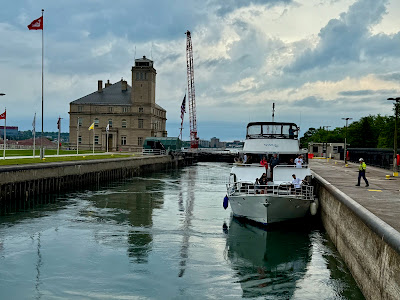The Soo Locks, located in Sault Ste. Marie, Michigan, are a remarkable feat of American engineering and a cornerstone of Great Lakes shipping. First constructed in 1855 by the State of Michigan, the original lock—known as the State Lock—was built to bypass the 21-foot drop caused by the St. Marys River rapids between Lake Superior and Lake Huron. Prior to its construction, ships had to unload their cargo and portage it around the rapids, a laborious and inefficient process that limited trade. In 1881, the U.S. Army Corps of Engineers took over operation and maintenance, expanding the system to meet growing commercial demands. Today, more than 7,000 ships pass through annually, transporting tens of millions of tons of essential cargo such as iron ore, coal, and grain, making the Soo Locks an enduring artery of North American industry and commerce.
The Museum Ship Valley Camp, moored in Sault Ste. Marie, Michigan, is a retired Great Lakes freighter built in 1917 and now open as an immersive maritime museum. Inside the holds are four impressive 1,200-gallon aquariums showcasing native Great Lakes fish, crew quarters including the captain’s cabin and more modest crew bunk rooms, and detailed shipwreck artifacts, models, paintings, and maritime memorabilia.
Our captain and narrator guided us through the journey with expert knowledge bringing the history and operation of the locks to life
Algoma Steel, located in Sault Ste. Marie, Ontario, is Canada’s second largest steel producer and a vital part of the country’s industrial landscape. Algoma specializes in manufacturing hot- and cold-rolled steel sheet and plate products, serving industries such as automotive, construction, energy, and manufacturing.
The stock piles of the three ingredients need to produce steel, iron ore, coke, and limestone. It takes 2.5 tons of these material to produce one ton of steel




















We visit Sault Ste. Marie Ontario often. Thank you for telling what that beautiful building is we see across the water and how it works and the history.
ReplyDeleteThanks for stoping by
Delete